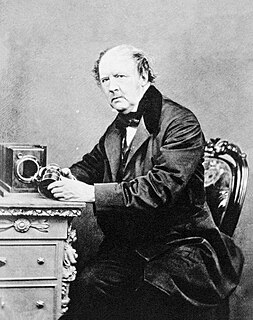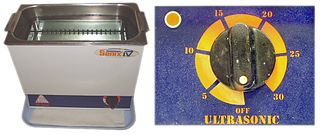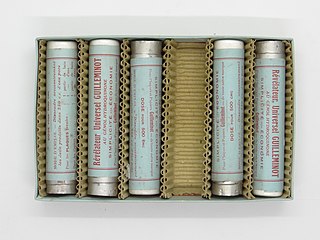
Calotype or talbotype is an early photographic process introduced in 1841 by William Henry Fox Talbot, using paper coated with silver iodide. The term calotype comes from the Greek καλός (kalos), "beautiful", and τύπος (tupos), "impression".

The collodion process is an early photographic process.

Schlieren photography is a visual process that is used to photograph the flow of fluids of varying density. Invented by the German physicist August Toepler in 1864 to study supersonic motion, it is widely used in aeronautical engineering to photograph the flow of air around objects.
Sheet film is large format and medium format photographic film supplied on individual sheets of acetate or polyester film base rather than rolls. Sheet film was initially supplied as an alternative to glass plates. The most popular size measures 4×5 inches; smaller and larger sizes including the gigantic 20×24 inches have been made and many are still available today.
The E-6 process is a chromogenic photographic process for developing Ektachrome, Fujichrome and other color reversal photographic film.

Gabriel Lippmann conceived a two-step method to record and reproduce colours, variously known as direct photochromes, interference photochromes, Lippmann photochromes, Photography in natural colours by direct exposure in the camera or the Lippmann process of colour photography. Lippmann won the Nobel Prize in Physics for this work in 1908.
Stop bath is a chemical bath usually used in processing traditional black-and-white photographic films, plates, and paper used after the material has finished developing. The purpose of the stop bath is to halt the development of the film, plate, or paper by either washing off the developing chemical or neutralizing it. With the former, a simple water rinse can be used between developer and fixer, but the development process continues for an indefinite and uncontrolled period of time during the rinsing.
The gelatin silver process is the photographic process used with currently available black-and-white films and printing papers. A suspension of silver salts in gelatin is coated onto a support such as glass, flexible plastic or film, baryta paper, or resin-coated paper. These light-sensitive materials are stable under normal keeping conditions and are able to be exposed and processed even many years after their manufacture. This is in contrast to the collodion wet-plate process dominant from the 1850s–1880s, which had to be exposed and developed immediately after coating.

A chiller is a machine that removes heat from a liquid via a vapor-compression or absorption refrigeration cycle. This liquid can then be circulated through a heat exchanger to cool equipment, or another process stream. As a necessary by-product, refrigeration creates waste heat that must be exhausted to ambience, or for greater efficiency, recovered for heating purposes.
C-41 is a chromogenic color print film developing process introduced by Kodak in 1972, superseding the C-22 process. C-41, also known as CN-16 by Fuji, CNK-4 by Konica, and AP-70 by AGFA, is the most popular film process in use, with most photofinishing labs devoting at least one machine to this development process.

Push processing in photography, sometimes called uprating, refers to a film developing technique that increases the effective sensitivity of the film being processed. Push processing involves developing the film for more time, possibly in combination with a higher temperature, than the manufacturer's recommendations. This technique results in effective overdevelopment of the film, compensating for underexposure in the camera.

Technical Pan is an almost panchromatic black-and-white film that was produced by Kodak. While it can reproduce the visible light spectrum, it leans to the red, and so unfiltered outdoor shots render blues, most notably the sky, with additional darkening and reds with some lightening. It was generally used as a very slow film, rated at EI 25 or even 16, although it could be rated at up to EI 320 with a distinct loss of tonal range and a bunching of shadow and highlight detail. This film has unmatched fine grain, especially when rated at a low speed, and makes excellent enlargements while preserving fine details. Kodak stopped selling it in 2004. It has not been replaced by a film with its characteristics.

A latent image is an invisible image produced by the exposure to light of a photosensitive material such as photographic film. When photographic film is developed, the area that was exposed darkens and forms a visible image. In the early days of photography, the nature of the invisible change in the silver halide crystals of the film's emulsion coating was unknown, so the image was said to be "latent" until the film was treated with photographic developer.

The Sabattier effect, also known as pseudo-solarization, is a phenomenon in photography in which the image recorded on a negative or on a photographic print is wholly or partially reversed in tone. Dark areas appear light or light areas appear dark. Solarization and pseudo-solarization are quite distinct effects. Over time, the "pseudo" has been dropped in many photographic darkroom circles and discussions, but the effect that is meant is the Sabattier effect and not the solarization by extreme overexposure.

In photography, toning is a method of changing the color of black-and-white photographs. In analog photography, it is a chemical process carried out on silver-based photographic prints. This darkroom process cannot be performed with a color photograph. The effects of this process can be emulated with software in digital photography. Sepia is considered a form of Black and White or Monochromatic Photography. https://www.chasejarvis.com/blog/sepia-what-the-hell-is-it/
Rodinal is the trade name of a black and white developing agent produced originally by the German company Agfa based on the chemical 4-aminophenol.

Ultrasonic cleaning is a process that uses ultrasound to agitate a fluid. The ultrasound can be used with just water, but use of a solvent appropriate for the item to be cleaned and the type of soiling present enhances the effect. Cleaning normally lasts between three and six minutes, but can also exceed 20 minutes, depending on the object to be cleaned.
Photographic emulsion is a light-sensitive colloid used in film-based photography. Most commonly, in silver-gelatin photography, it consists of silver halide crystals dispersed in gelatin. The emulsion is usually coated onto a substrate of glass, films, paper, or fabric.
















